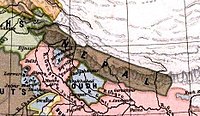| History of Nepal |
|---|
 |
|
|
Panchayat (Nepali: पञ्चायत) was a political system in Nepal from 1961 to 1990. It banned political parties and placed all governmental power, including power over the Council of Ministers and Federal Parliament, under the sole authority of the king; this made the country a de facto absolute monarchy.[1]
After sidelining the Nepali Congress government of B. P. Koirala on 15 December 1960 (1 Poush 2017 BS) in a coup d'état, King Mahendra introduced the panchayat system on 5 January 1961 (22 Poush 2017 BS). Mahendra introduced a four-tier structure (village, town, district, and national) based on limited elected executive committees. The king consolidated power by institutionalizing three pillars of national identity – Hinduism, the Nepali language, and the monarchy – as foundations of everyday social and religious life. This was encapsulated in the slogan, Ek Raja, Ek Bhesh, Ek Bhasa (one king, one dress, one language).[2]
Popular discontent with the panchayat system grew and exploded on 18 February 1990, when the banned Nepali Congress and the United Left Front (a coalition of left-wing Nepali parties) launched a campaign of popular demonstrations and strikes to end the system and restore multiparty democracy. The campaign, later known as the People's Movement, compelled King Birendra to lift the political-party ban on 8 April of that year and end the panchayat system that had dominated Nepal for almost 30 years.[3]
- ^ "Panchayat System in Nepal Part-I - GKToday". www.gktoday.in. Archived from the original on 1 March 2023. Retrieved 28 February 2023.
- ^ KC, Pranab Kharel & Gaurab. "Reassessing Panchayat". My Republica. Archived from the original on 2 June 2024. Retrieved 3 September 2020.
- ^ "Nepalese force king to accept democratic reform, 'Jana Andolan' (People's Movement), 1990 | Global Nonviolent Action Database". nvdatabase.swarthmore.edu. Archived from the original on 30 November 2022. Retrieved 1 March 2023.